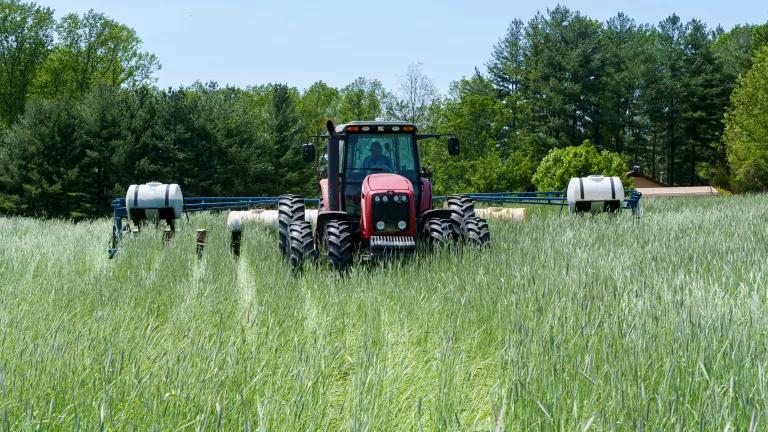If a federal agency willfully buries its head in the sand, what will it take to pull it out?
As I discussed here, sampling of ground turkey, pork chops and ground beef in U.S. supermarkets, conducted jointly by the Food and Drug Administration (FDA) and the Centers for Disease Control and Prevention in 2011, found a marked increase in antibiotic-resistant bacteria on retail meat. This week, a new report published by our colleagues at the Environmental Working Group has brought renewed attention to the issue—and a heavy dose of disgust, well expressed by Tom Laskawy in his recent Grist post, the title of which I won’t reprint here.
Detecting resistant pathogens on meat is a sign that the “superbugs” generated on factory farms through careless use of antibiotics are leaving these facilities. But while Americans might be surprised to learn that a majority of supermarket meat is contaminated with resistant superbugs, the FDA can’t feign surprise.
In fact, the agency responsible for ensuring the safety of our food has known for decades that the misuse and overuse of antibiotics in the livestock industry is contributing to the rise of antibiotic resistance and putting the effectiveness of the drugs we rely on—and therefore all of our health—at risk. Nonetheless, they’ve done close to nothing to address the problem.
Here’s a brief interactive history of FDA’s failure to act on this critical public health issue:
According to the FDA itself, 70% of all medically important antibiotics sold in the U.S. are used in food animal production. In 2011, four times the amount of antibiotics was sold for use on chickens, pigs, cows and other food animals than for human medicine.
The vast majority of these precious drugs aren’t given to animals that are sick. Instead, they’re used as a substitute for better management practices—to prevent disease in crowded and unsanitary factory farms—and to promote faster growth. These conditions create the perfect environment for those bacteria that are resistant to the antibiotics to multiply and thrive, creating more and more resistant superbugs. In fact, you really could not design a better system for guaranteeing the spread of antibiotic resistance.
As FDA’s own sampling shows, superbugs can and do travel on meat. But meat is just one of the ways they can enter our environment. Resistant pathogens can hitch a ride out of feedlots on workers who come into contact with contaminated animals or meat, through water, soil, and air that comes into contact with contaminated animal waste, and through bacteria sharing resistance traits/genes with one another. Nonpathogenic bacteria can even share these traits with pathogenic bacteria.
Once they’re out, this can lead to antibiotic resistant capabilities being spread far and wide. Resistant bacteria on a doorknob or on a piece of unwashed fruit or in a hospital can result in really severe illnesses. Superbugs can’t be knocked out with the usual medicines. If a child catches one of these, a simple ear infection could put her in the hospital – or worse.
In case the FDA needs any more information to take action, the most prominent medical and public health groups are all on record sounding the alarm that the “overuse and misuse of important antibiotics in food animals must end, in order to protect human health.”
Here at NRDC, my colleagues have sued FDA to compel the agency to act—and we’ve won. Twice. FDA has appealed the two legal victories and we continue to fight it out in the courts.
But you don’t need a law degree to take action. Just knowledge and your appetite.
Every day, farmers across the country show that we can produce meat in ways that don’t require massive reliance on these precious miracle drugs. And concerned consumers across the country have voted with their wallets, helping to bring an abundance of meat and poultry products raised without antibiotics into the marketplace. Besides demonstrating the viability of production systems that don’t rely on unsafe uses of antibiotics, this means it’s easier and easier to demonstrate your preference for meat produced without antibiotics each and every time you go to the grocery store.
According to Consumer Reports (CR), at least one of the 13 largest supermarket chains in the country, Whole Foods, offers nothing but meat and poultry raised without antibiotics in its meat department. Most other major chains offer some such products. CR also found that the prices for meat and poultry raised without antibiotics are not prohibitive, with a number of supermarkets offering chicken without antibiotics at prices competitive with all chicken prices nationally.
So educate yourself, educate your friends, and most importantly speak up. Look for alternatives: meats labeled USDA Organic, those which say “no antibiotics administered” and carry the USDA Process Verified seal, as well other labels which certify practices are best; but consider labels with producer claims of “no antibiotics administered” without certification if certified labels are not available. Better yet, ask your supermarket butchers and store managers if the meat they’re selling was raised with routine use of antibiotics or not.
Consumers—and the supermarkets that sell us our meat—have a choice. As of 2010, the average American bought and ate about 200 pounds of meat and poultry per year. If supermarkets no longer stocked meat and poultry raised with antibiotics, antibiotic use in livestock production would drop dramatically. It’s that simple. But to make it happen, supermarket managers need to hear from us that we no longer want drugged up meat in our stores or on our plates. We all need to stand up say that we put the health of people first and want to protect the life-saving drugs we need for our families.



